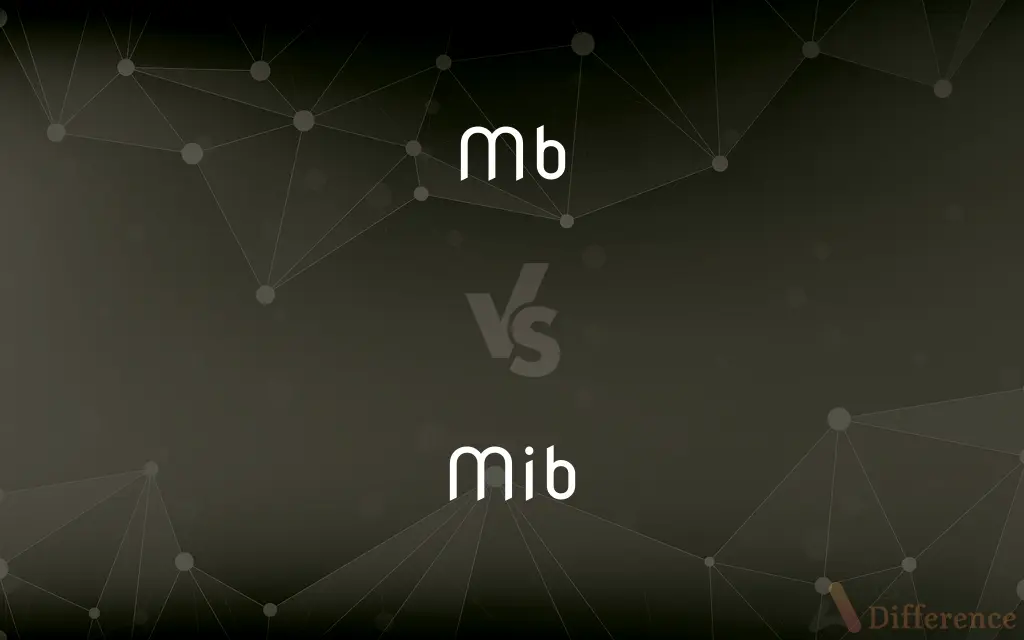Mb vs. Mib — What's the Difference?
Edited by Tayyaba Rehman — By Urooj Arif — Updated on April 25, 2024
MB (Megabyte) uses a decimal system for storage calculations, representing 1,000,000 bytes, while MiB (Mebibyte) uses a binary system, equaling 1,048,576 bytes.

Difference Between Mb and Mib
Table of Contents
ADVERTISEMENT
Key Differences
MB, or Megabyte, is commonly used in the context of data storage and represents 10^6 (1,000,000) bytes, following the SI (International System of Units). On the other hand, MiB, or Mebibyte, follows the binary system and represents 2^20 (1,048,576) bytes, which is used primarily in computing to ensure precision.
In practical terms, MB is often used in everyday digital storage and media, such as hard drives and USBs, while MiB is more prevalent in software and computing contexts where binary precision is necessary.
When discussing digital storage prices or capacities, MB is the more familiar unit in marketing and consumer products. Meanwhile, MiB, though less known, provides a more accurate measurement in software engineering and computer science contexts.
Operating systems and certain software applications might report storage using MiB, which can lead to confusion for users accustomed to MB, as the numbers appear smaller in MiB.
For data transmission rates, such as internet speeds, MB is frequently used, which can sometimes lead to misunderstandings about actual download and upload speeds when not accounting for the binary-based MiB that some applications might use.
ADVERTISEMENT
Comparison Chart
Base Unit
Decimal (Base 10)
Binary (Base 2)
Equivalent Bytes
1,000,000 bytes
1,048,576 bytes
Context of Usage
General computing, storage, and media
Precise computing, software, OS
Consumer Recognition
High (common in marketing)
Lower (technical contexts)
Precision
Less precise for technical computing
More precise for system memory
Compare with Definitions
Mb
A unit of digital information commonly used to measure file sizes and data storage.
A standard JPEG image from a digital camera is typically about 2 MB.
Mib
Unit Information.
A unit of information equal to one million (1,048,576) bytes.
Mb
An approximate measure of data volume that simplifies understanding of digital content size in everyday technology use.
An average MP3 file of a song is about 3 to 5 MB in size.
Mib
A unit of digital information used in computing that is based on powers of two, more precise for technical purposes.
A software application might require 500 MiB of disk space for installation.
Mb
Reflects the amount of data in millions of bytes, using a base of ten, suitable for general consumer understanding.
A one-minute video at high quality could be roughly 15 MB.
Mib
Represents a binary approximation of data storage, providing specificity required in system programming.
Operating systems often display RAM usage in MiB to provide exact figures.
Mb
(a British degree) a bachelor's degree in medicine
Mib
(games) A marble (glass ball used in games), especially one used as a target.
Mib
(in the plural) A game of marbles.
Common Curiosities
Where is MB most commonly used?
MB is most commonly used in everyday digital products and storage, such as USB drives, SD cards, and common software applications.
Where is MiB most commonly used?
MiB is commonly used in operating systems, programming, and other areas that require precise memory and storage specifications.
What does MB stand for?
MB stands for Megabyte, a unit of digital information or computer storage.
What does MiB stand for?
MiB stands for Mebibyte, also a unit of digital information, but using a binary counting system.
What impact does the difference between MB and MiB have on purchasing storage devices?
Consumers may notice discrepancies in reported versus actual storage capacity due to the difference in how manufacturers may label products using MB (decimal) versus the operating system reporting in MiB (binary).
How does the difference between MB and MiB affect internet usage?
For internet data plans, the difference affects how data usage is calculated and reported, potentially leading to misunderstandings about data limits.
How does the usage of MB and MiB affect computing?
The usage of MB can lead to approximate calculations in storage capacity, whereas MiB provides more accuracy and is preferred in technical fields that require precision.
Why do some operating systems use MiB while others use MB?
Some operating systems choose MiB for accurate reporting of memory and storage, aligning with binary system conventions, while others use MB for consistency with general consumer expectations.
How do you calculate the difference between MB and MiB?
To find the difference, you can calculate the percentage difference between the base 10 and base 2 values, with MB being approximately 4.86% less than MiB.
Are there legal implications in using MB vs. MiB in product specifications?
Yes, incorrect or unclear labeling regarding MB and MiB can lead to consumer confusion and potential legal challenges concerning false advertising.
Is there a conversion formula for MB to MiB and vice versa?
Yes, to convert MB to MiB, divide by approximately 1.048576; to convert MiB to MB, multiply by approximately 1.048576.
What educational concepts are important for understanding MB and MiB?
Understanding the decimal and binary systems, as well as basic computer memory architecture, is crucial for grasping why different units are used.
Do mobile phones use MB or MiB for storage reporting?
Most mobile phones report storage capacity in MB, aligning with the common usage in consumer electronics marketing.
How do software developers decide whether to use MB or MiB?
Software developers base their decision on the intended user base and application requirements, choosing MiB for technical accuracy in computing environments.
How can consumers avoid confusion between MB and MiB when buying products?
Consumers can educate themselves about the difference and check product specifications carefully, or use tools and calculators that convert between MB and MiB to understand the true capacity of storage devices.
Share Your Discovery

Previous Comparison
Feces vs. Stool
Next Comparison
Jungle vs. RainforestAuthor Spotlight
Written by
Urooj ArifUrooj is a skilled content writer at Ask Difference, known for her exceptional ability to simplify complex topics into engaging and informative content. With a passion for research and a flair for clear, concise writing, she consistently delivers articles that resonate with our diverse audience.
Edited by
Tayyaba RehmanTayyaba Rehman is a distinguished writer, currently serving as a primary contributor to askdifference.com. As a researcher in semantics and etymology, Tayyaba's passion for the complexity of languages and their distinctions has found a perfect home on the platform. Tayyaba delves into the intricacies of language, distinguishing between commonly confused words and phrases, thereby providing clarity for readers worldwide.
















































